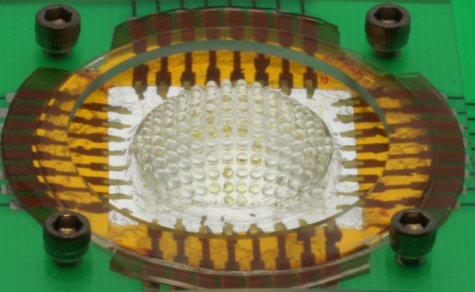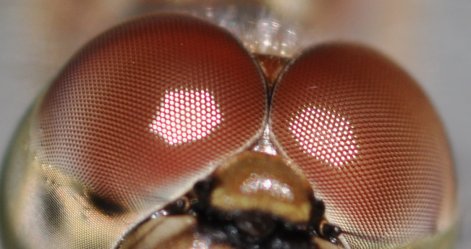
There are two basic designs for animal eyes: “simple” eyes and compound eyes. Your eyes are called “simple” eyes, because each has only one lens. The lens focuses light that enters your eye onto a layer of tissue called the retina, which has light-sensitive cells. Those cells detect the light and send electrical impulses to your brain, which then produces an image of what the eye is seeing. In contrast, many arthropods (a broad class of animals including insects, crustaceans, spiders, etc.) have compound eyes. Each compound eye has many lenses, and each lens focuses light onto its own set of light-sensitive cells. The brain then collects the information from each of these optical units (called ommatidia) and produces a composite image.
Each eye design has its own strengths and its own weaknesses. A simple eye produces a very sharp image of whatever the lens is focused on. However, the farther anything is from the center of a simple eye’s vision, the more distorted it becomes. In addition, a simple eye has a narrow depth of field. When it focuses on an object, other things in the field of view are blurry if their distance from the eye is much different from the object being focused on. The compound eye, on the other hand, does not produce very sharp images. However, because its lenses are so small, there is very little distortion of objects that are away from the center of the eye’s view. In addition, the small lenses have a nearly infinite depth of field – objects stay in focus whether they are near or far from the eye.
The practical upshot is that compound eyes tend to be very valuable if you want a wide, panoramic view. In addition, they are very sensitive to motion. If you’ve ever tried to swat a fly, you understand that. The fly seems to see your hand no matter how slowly you move it or where you are relative to the fly. Simple eyes, on the other hand, are more valuable if you want very a very sharp, clear image of what you are focused on. So far, the cameras produced by human science and technology have been modeled after simple eyes. They give sharp, clear images of what the camera focuses on, but the view is not panoramic and the depth of field is narrow.
Now that has changed.
In the May 2nd, 2013 issue of the journal Nature, a remarkable achievement in the field of optics was announced – researchers described digital cameras that mimic a compound eye.1 A picture of one of those cameras is shown above. Notice how it has several lenses (the “bubbles” of glass) arranged on a hemisphere. Each of those lenses focuses light onto a digital detector, which then renders an image of what that one lens sees. Optical models are then used to produce a composite image that combines information from all the lenses.
Why would the researchers bother to develop such an eye? Here’s how they put it:
The compound eyes of arthropods are particularly notable for their exceptionally wide fields of view, high sensitivity to motion and infinite depth of field. Analogous man-made cameras with these characteristics have been of longstanding interest, owing to their potential for use in surveillance devices, tools for endoscopy and other demanding applications.
Imagine, for example, a drone that has an on-board camera which provides a panoramic view of its surroundings and doesn’t have to decide what to focus on. Obviously, it would be superior to what is available right now. Or consider a camera on the end of a surgeon’s scope. Rather than needing to decide what to look at, the camera provides a wide-angle shot of the patient’s digestive system as the camera travels through it.
Obviously, there is still a lot of work to do in order to get this kind of camera to the point where such applications can be realized. The resolution of the camera, for example, depends on the number of lenses. As one of the authors on the Nature paper says, the camera described in the paper is a “low-end insect eye.” It has “only” 180 separate lenses, while arthropod eyes range from having as few as 6 (in some worker ants) to as many as 30,000 (in some dragonflies).2 The authors state that their design is scalable, however, and they think it can be used to make cameras that are even better than dragonfly eyes.
Before I end this discussion, I need to bring up two points. First, I want you to go back to the top of the page and look at the picture of the camera that comes from this remarkable achievement. Is there any doubt that the camera is the product of design? Of course not! Now I want you to look at this picture, which is a closeup of a dragonfly’s eyes:

These eyes are significantly more elegant, significantly more sophisticated, and provide significantly more resolution than the camera pictured at the top of this post. However, there are some who desperately contend that these eyes are not the result of design! I simply do not understand the mental gymnastics needed to accept that a crude mimic of a natural structure is clearly the result of design while the elegant, sophisticated natural structure is not.
Second, remember that the earliest eyes seen in the fossil record are compound eyes that have 3,000 individual lenses. In addition, the lenses in these fossil eyes are designed just like the lenses in the eyes of modern arthropods. These fossil eyes are supposed to be 515 million years old, yet they are superior to what modern technology can produce! Also, no precursors have been found in the fossil record. The fossil record goes from animals with no eyes to animals with eyes that are superior to what our modern technology can produce in supposedly a mere 120 million years.
I simply cannot muster enough faith to believe that evolution can produce such amazing technology in so short a period of time!
REFERENCES
1. Young Min Song, Yizhu Xie, Viktor Malyarchuk, Jianliang Xiao, Inhwa Jung, Ki-Joong Choi, Zhuangjian Liu, Hyunsung Park, Chaofeng Lu, Rak-Hwan Kim, Rui Li, Kenneth B. Crozier, Yonggang Huang, and John A. Rogers, “Digital cameras with designs inspired by the arthropod eye,” Nature 497:95-99, 2013
Return to Text
2. Alexander B. Klots and Elsie B.Klots, 1001 Questions Answered About Insects, Dover Publications 1977, p. 107
Return to Text

As always so full of information and fascinatingly made relevant with current events. Enjoy greatly.
Fascinating! I too am dumbfounded as to how anyone would consider compound eyes to be the result of random processes. I believe the public school system (which in my opinion brainwashes children to a certain extent) is to blame.
“However, there are some who desperately contend that these eyes are not the result of design! I simply do not understand the mental gymnastics needed to accept that a crude mimic of a natural structure is clearly the result of design while the elegant, sophisticated natural structure is not.”
Agree 100%
Dr. Wile,
Thanks for the interesting and informative article! Reading about compound lens cameras immediately made me think of the cameras used to capture Google Street-view.
Do you happen to know how these cameras work? Are they similar to compound lens cameras? If not, do you think that would be a good application of the technology?
Also, what is the advantage of having a multiple lens camera as opposed to have a computer processing the images of multiple regular cameras situated at different angles?
Thanks for keeping up this blog!
Thanks for your questions, Enoch. As I understand it, the Google Street-View images are all caught by single-lens cameras mounted on vehicles. Most of them are mounted on cars, but some are even mounted on tricycles so as to get images on footpaths and other byways that aren’t accessible by car.
I am not sure how applicable a compound-lens camera would be for such an application, because we tend to want to see images that are similar to the way we see. A spy drone can be programmed to make use of the advantages of a compound-lens camera. I am not sure people would appreciate the images that come from such a camera.
The major advantage to the compound-lens camera is the nearly infinite depth of field. Because the lenses are so small, all objects are in focus regardless of how far they are from the lens. Thus, the spy drone doesn’t have to “decide” what to focus on. With a bunch of single-lens cameras, software would have to keep continually shifting focus to see everything. That would take lots of time and energy.